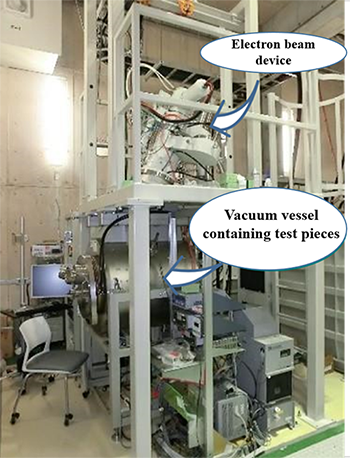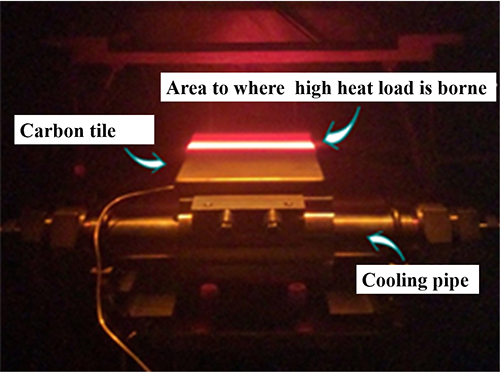HOME > Research Activities > Research Updates >
In recent years at the National Institute of Fusion Science(NIFS), “engineering science research on constructing a fusion power plant” has become all the more important because of the advancement in the understanding of plasma physics and of the increasing size of the experimental device. One such topic is constructing a fusion reactor wall (first wall) that is strong against heat.
In a device with magnetic field confinement, we confine the plasma in the magnetic field container. However, some particles escape to outside from within the plasma, strike the device’s inner wall, and provide heat. The heat per unit area is called the heat load. In the inner wall, in particular, the heat load in the divertor increases, because the plasma directly strikes the divertor material. In the future fusion reactor, the divertor’s heat load is expected to exceed 10 MW/m2 (MW = 106 watts). This is approximately equal to the heat load on the inner wall of a space rocket engine’s skirt (the place where fire is blown), and in the future fusion reactor the divertor will be exposed to this amount of heat continuously through the year. Of course, the reactor wall will be cooled by coolant such as water. However, this will be a very difficult condition. In order to withstand this condition, for the reactor wall material and structure, the high melting point (even at high temperatures this does not melt) and the high heat conduction (the heat is quickly released) become important. Now, research groups around the world are conducting research and development on new materials and structures that fulfill these conditions.
In order to determine whether various new materials in current research or technique that bonds materials may be used for the fusion reactor, it is necessary to investigate that these materials and technique “can actually be used.” Thus, at NIFS, we have developed the super high heat-flux test device ACT2 (Active Cooling Teststand 2) using a large-scale electron beam. ACT2 with the highest power of 300 kW electron beam of which diameter can be focused to 2 cm is a device for undertaking heat load tests of new materials. ACT2 is able to provide heat load of more than 10MW/m2 envisaged in the fusion reactor to small test pieces. Moreover we make the operation of ACT2 flexible. For example, by gradually raising the heat load it is also possible to perform tests over a wide range of temperature and to conduct the heat fatigue test of new materials by providing several thousand heat cycles by turning the electron beam on and off every few seconds.
Here, some recent research achievements using ACT2 are introduced. At NIFS, in order to make a new divertor that has high heat removal capability, a new technique has been developed which joins tungsten (which has the highest melting point among metals) and copper alloy (which has high heat conductivity). (For details please refer to back number 276.) We made a test module of a divertor using this joining technique and conducted a test that deposited heat load envisaged in the reactor by using ACT2. As a result we could confirm high heat removal capability. A first wall of the reactor where heat load is lower than at the divertor must be of high mechanical strength in some parts. Prospective materials for those parts are silicon carbide and a special steel. A test module was made by using these materials and a heat load test was conducted at ACT2. It was confirmed that the first wall material has enough strength without fracture. Moreover, being derived from these material researches, new research has started that measures how material is deformed by heat. It has been difficult to measure the deformation of heated materials by technique hitherto. A new method is being developed by using a special camera. Research on coolant for the first wall is being advanced. In order to improve cooling capability it is thought that the “swirling flow” is effective where coolant flows helically in the undulating flow path. A test module that simulates “swirling flow” was tested at ACT2 and the improvement in the cooling capability of swirling flow was clearly confirmed.
As seen from the above, the engineering research for making a heat resistant first wall is advancing by using ACT2. In the future, we will continue heat load tests using ACT2 in order to improve performance of the first wall and to contribute to the realization of fusion energy.

Image 1: A photograph of the Active Cooling Teststand 2

Image 2: A photograph at the time of heat load test of the LHD divertor using ACT2
Using the electron beam, the place where the high heat load is borne is a long narrow glowing strip. Carbon, which is strong against heat, is used for the LHD divertor.
